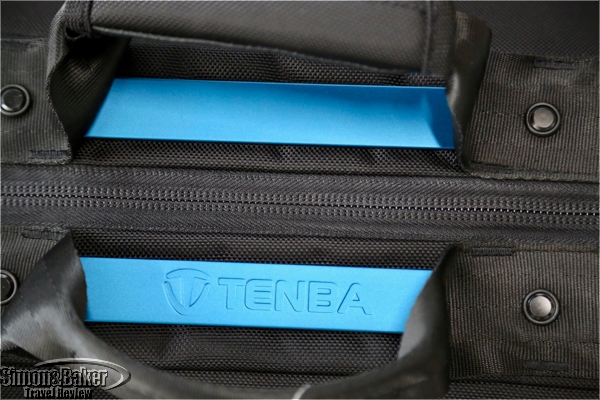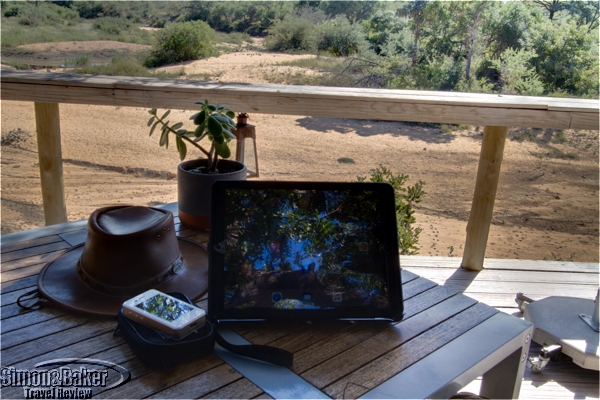by Editor | Nov 13, 2017 | Products
Article and photos by Aaron Lubarsky

The Cineluxe Backback 24
The Cineluxe Backback 24 by Tenba (Tenba, 75 Virginia Road, North White Plains, New York 10603, +1 914 347 3300, www.tenba.com, info@tenba.com) is a simple, large, lightweight backpack bag, made in China, designed for professional cinema cameras and electronic news gathering (ENG) rigs. On the road it was a non-nonsense, durable, weather-resistant bag that solved a specific problem: how to best carry a large fully built (with all the camera components assembled) camera rig on my back.

The backpack straps
It improved my efficiency in the field. The doctor bag style opening was a refreshing design innovation, allowing the camera to remain fully assembled and ready to go, which is a huge convenience for run-and-gun style filming or when time is a factor.

The interior of the Tenba Cinelux Backpack 24
The bag is large (13.5 wide by 24 tall by 14.25 deep, inches), but surprisingly nimble. Weighing eight pounds it was practical for quick moves from location to location, thanks to a comfortable harness and straps, and weathered tough conditions thanks to a body armor base panel.

A closer look at the compartments

The handles are reinforced
The two side pockets didn’t open entirely because they were designed to hold shotgun mics, matte boxes, and flags. For that purpose they performed well, but there wasn’t an easily accessible pocket for small items like my wallet or cellphone. It’s not that kind of bag.


Color coded padded wraps
And it’s not the kind of heavy, solid bag I would check-in at the airport or load up with lots of accessories. It is too big for lean and small camera set-ups. It has the elegant touches I have liked on other Tenba bags, including attractive blue metal bands engraved with the Tenba name and a leather trimmed handle.
by Editor | Oct 30, 2017 | Luxury Travel, Products
Article and photos by Aaron Lubarksy

The Tenba 21 Hybrid Roller
I really wanted to love the Tenba 21 Hybrid Roller (Tenba, 75 Virginia Road, North White Plains, New York 10603, +1 914 347 3300, www.tenba.com, info@tenba.com). On paper it’s the perfect camera bag: a solid, versatile, roller bag that I can also throw on my back. On the road its performance was mixed. It was a terrific bag with a couple of small but maddening flaws that drove me a little nuts on a recent shoot.

The Hybrid Roller offered a generous amount of storage space.
The Hybrid Roller, made in China, offered a generous amount of storage space, flexibility, and elegance. It had plenty of zippers and inner pockets, including a removable padded camera insert. It comfortably held everything I needed for a recent DSLR shoot, including my sound gear and a laptop. The interior dimensions of the bag were 12 wide by 17 tall by 7 deep, in inches. It had a handy drop-in tripod carrier which was a nice (and space-efficient) touch. If I wanted security, this bag had me covered with two built in locking mechanisms: a steel security cable and lock plus an integrated TSA (Transportation and Security Administration) approved zipper lock. Like other Tenba bags I have used, the roadie 21 was durable, weather resistant and a cut-above the competition in terms of luxury and style. I liked it for carry-on luggage.

The Hybrid Roller single exterior pocket
As someone who likes to keep things organized I love pockets and compartments, so a minor gripe I had with this bag was the lack of an easily accessible exterior pockets (for a boarding pass, water bottle, kindle, snack, chargers). The Hybrid Roller only had only one exterior pocket, which made the bag look sleek and discrete, but limited its practicality for travel. While the exterior could have used more pockets, the interior delivered on that front and provided a safe home to my gear.

The built-in steel security cable and lock
However, the backpack part just didn’t cut it for me. The bag lacked the kind of padding and contours that are a natural feature in most bags designed to be backpacks I have used. When on my back it was uncomfortable and rigid, the straps felt thin, and the bag felt heavy and bulky (it weighed 11 pounds empty). It was my primary bag on a recent three day travel shoot from New York City to Utah and Idaho. By day two I was only using it as a roller bag.

The integrated TSA approved zipper lock
I was hoping as a hybrid I could easily switch from backpack to roller bag, but when I had the backpack area opened, the straps would get caught in the wheels, ruining my flow (and the straps). Bottom line: to use it as a roller bag, I needed to first put away the backpack set-up (or cut the straps). For my colleagues who want a hybrid bag, and have the patience to withstand some discomfort and set-up, this bag packed a punch, but I recommend committing to the roadie 21 roller bag, not the hybrid version.
by Editor | Jul 31, 2017 | Ecotourism, Products
Article and Photos by Gary Cox

The Tenba Shootout Backpack 32L
Planning camera gear for an extended trip to Africa with location changes every two or three days starts with a solid transport solution. I don’t like anyone carrying my equipment, figuring that if someone is going to break stuff, it should be me. For my most recent trip, I chose the Tenba Shootout Backpack 32L (Tenba, 75 Virginia Road, North White Plains, New York 10603, +1 914 347 3300, www.tenba.com, info@tenba.com), and returned home happy with the decision and the performance of the bag. This is not a general purpose pack with some foam dividers stuffed into it, this is a backpack purpose built from the ground up for the photographer on the go.

My backpack has shoulder straps and a padded belt to distribute weight to the hips when worn.
The exterior of the backpack was made from water repellent twill and gray rip stop nylon. The interior compartments were built with rip stop nylon and soft tricot fabric, padded with perforated foam to minimize weight (six pounds empty). The center of the bag is for camera storage and featured water resistant pockets on the panel for storing memory cards and small items. It has full height pockets, one large on the front and one on the side for thin items. The other side has a half height pocket and an opening into the main chamber for quick access to a camera without unzipping the entire bag. There are some small organizing pockets on the front for miscellaneous items.

The padded handle allowed me to carry the load comfortably.

The side pocket gave me access to the main compartment and had a mesh pocket to store small items securely.
Near the handle on the top, there is a solid compartment to store fragile items. During the trip the compartment kept my sunglasses from being crushed. There is also a set of straps and a harness to attach a large tripod on the outside of the bag. A zippered compartment on the bottom holds a waterproof cover that can be pulled up over the bag like a little raincoat to keep it dry. Between the main compartment and the padded back brace and frame, there is a slot for a laptop or tablet. The zippers to the main compartment and front pocket can be locked with a small padlock, not included. The backpack, made in China, came with a small microfiber cloth and memory card wallet.

Opening the front pockets revealed more pockets for small items.
On safari trips to gather data on properties for the Simon and Baker Travel Review, I cannot afford to have any gear sidelined, so redundancy for key items is critical. On one trip, my wide angle lens bumped into the iron plating on the game viewing vehicle and broke. Apparently these are not in high demand for the average traveler in Botswana, and it was several days before I could get a replacement lens. I learned multiple lessons, pad everything during transfers and carry spares. The next challenge is the variety of shooting situations and the volume of photos I take. My go-to lens for general wildlife photography is the Canon 100 to 400 millimeter. It is versatile and a reasonable trade-off between weight and capability. On this trip, I included a 70 to 300 millimeter lens with the backup camera body.

The camera equipment for our trip to Africa
I laid everything out before packing and started to wonder if the pack came in a larger size. Two camera bodies (Canon EOS 7D), two telephoto lenses, two wide angle lenses and a 28 to 130 millimeter for general purpose shooting. Flash, straps, batteries, chargers, memory cards, special purpose filters, macro adapter lens, cleaning supplies and iPad rounded out the final mix. It was a little tight, but everything fit and was well organized thanks to the bag’s dividers and pockets, including the handy well at the top for my sunglasses and mp3 player. With this load the backpack weighed over 30 pounds.

The main compartment held most of the camera gear
The fully loaded pack was comfortable to wear and distributed the weight across my shoulders and back. I am not a small guy and the straps had plenty of length, something I often find deficient in camera packs. The handle on the top of the bag was sturdy. The loaded pack rested upright and did not fall over when I set it on the ground. The padded belt could be a little annoying when I placed the bag into a cabinet or closet, but when I wore the backpack it was a godsend for balance and load distribution.

The Tenba Shootout Backpack 32L is padded and has a built in frame for stability.
The side of the bag has an easy access pocket to pull out a camera, but I never used that feature because my gear was too snug in the pack. I liked that the bag had lots of room for small things. It made it easy to keep organized. I used the pockets inside the main compartment for most of the memory cards and other valuable items. The outer pockets were handy for quick access, and ended up full of things I picked up when changing locations and then tidied away once we had rooms again. The tall side pocket was just right to hold my travel tripod. For the long haul flights I packed it away and only used the side pocket feature when changing properties in country. The zippers had nice easy to grab attachments and none of them became jammed or stuck.

A strap allowed me to attach a tripod to the outside of the backpack.

There were rings to attach external items on the shoulder straps
The bag held up well in extreme and varied conditions. For example, for the first 10 days we had intermittent rain and many opportunities to get muddy. The other three weeks were dry and dusty with a total of 12 property changes on planes, cars, vans and open safari vehicles. Everything inside my bag stayed safely clean and dry the entire time, and backpack arrived home looking new in spite of the opportunities to get muddy and dusty in the field. While pushing the luggage cart to the car in the parking lot at the airport at the end of the trip, the cart jammed solidly into a grating and the camera backpack flew off the top of the pile of bags landing on the parking lot surface. I assumed that a five foot forward flight and a four foot drop onto concrete would mean something was broken, but when I opened it at home, nothing was cracked or damaged. I would not recommend testing the backpack in that way, but it was good to know that when I let my guard down, the bag kept the contents unharmed. The Tenba Shootout Backpack 32L is my new choice for an expedition backpack to keep my gear safe.
by Editor | Jul 3, 2017 | Products
Article and photos by Gary Cox

Lounging on the porch with my iPad and the RoamingMan hotspot in the Thornybush Nature Reserve
On our most recent safari trip to South Africa we took a 353 gram RoamingMan (RoamingMan, Ucloudlink (America), Ltd, 119B Hester St, New York, NY 10002, www.roamingman.com, supportus@roamingman.com) hotspot device, to connect to the internet with our electronic devices (laptop and tablet) using the nearest and strongest cellphone signals. Although most of the lodges where we stayed offered complimentary WiFi, many of the networks were unsecured, allowing anyone with a WiFi card and some basic skills to become an amateur eavesdropper. Others required a password known by many staff and guests. Because cellular 4G networks are encrypted and require expensive specialized equipment to hack we often felt safer using our personal hotspot than the property’s WiFi. The RoamingMan device also provided internet access while we were transferring between properties, which was often a good time for us to go online and check emails.
Operating the device was easy. We turned it on and connected to the WiFi using the password on the screen. The 4G connection was fast enough to be useful for web browsing and emails. The hub, manufactured in China, was a little larger than a deck of cards and solidly built with a few simple controls. It weighed about eight ounces, came with a charging cable and was packed in a zippered case. The internal battery, rated to last up to 15 hours, held its charge when powered off for several days.

The RoamingMan WiFi device came with a charging cable and a zippered case.
Almost every device we travel with requires USB power to charge these days, and the charging cable had a pass through plug on the back, allowing multiple devices to charge from a single adapter. It performed double duty, as a WiFi hotspot and a standby battery pack for emergency charges, able to charge a cell phone or mp3 player in a pinch, a feature that came in handy a time or two.
RoamingMan rented the small Android based hub for a daily flat rate with unlimited data. The device we used was a customized version of the GlocalMe, with support provided by RoamingMan instead of the manufacturer. The WiFi hub used a cloud based SIM technology to allow global roaming, supposedly finding the best rate and connection, but what was critical to us is that it mostly worked well in South Africa. There was one day when we drove through the mountains in the Blyde River Canyon where reception was poor, but that was the exception. Connectivity was good in most places we tried.

While sitting by the dry riverbed at The River Lodge I connected to the internet with the RoamingMan hotspot and my tablet
Delivery was of the hotspot unit stateside was efficient and convenient. The company shipped the device before we departed and activated it on the date we requested. When we returned home, we packed it into the shipping box, placed on the return label they provided and dropped it off a local UPS pickup spot. We were glad to have it with us, for the extra security of using cellular data without the challenges of figuring out the costs. This is one simple to use device that we will consider packing for future international adventures.

by Editor | Apr 3, 2017 | Products
Article and photos by Aaron Lubarsky

The Tenba 15 Cooper Bag was made from a light grey canvas material with black leather accents.
The first thing I noticed about the Tenba 15 Cooper Bag (Tenba, 75 Virginia Road, North White Plains, New York 10603, +1 914 347 3300, www.tenba.com, info@tenba.com) was that it is handsome, movie star handsome. Made from a light grey canvas material with black leather accents, the minimal design is at once sophisticated and restrained. Style-wise it was a big upgrade from my bulky black Lowepro camera backpack.

I counted ten pockets
I recently put the Cooper 15 through its paces during a documentary shoot in San Francisco, California. I flew from New York, and as a carry-on bag it’s a class-act with enough exterior pockets and pouches to handle all of my needs, from a water bottle to a Kindle to a boarding pass. Tenba says the bag has “tons of pockets” but I counted ten, which was sufficient for me, including two slim expandable side pockets. The compartment for the laptop was easily accessible and just padded enough to comfortably hold my 15 inch MacBook Pro.

The bag’s interior was deceptively large.
Made in China, it’s light weight (3.6 pounds) with a peach-wax cotton canvas water-repellent exterior. The base is leather and waterproof, a feature I appreciate, although it doesn’t feel like the kind of bag that I would take out in rough weather conditions, even though it should be able to handle it.
The bag’s interior was deceptively large. Its dimensions are 15 inches wide by 11 inches tall and 6.5 inches deep. I was able to pack all of my regular gear (including sound gear) with room to spare. Surprisingly, it held as much as my larger, bulkier camera backpack. It has a removable padded camera insert, which I configured to my taste. Because the storage area is one large deep pocket, I had to stack things on top of each other. When I had a lot of items it was necessary to do a little unpacking to grab what I needed, which wasn’t ideal for run-and-gun situations.

It held as much as my larger, bulkier camera backpack.

A shoulder bag that fits in anywhere
But, I wouldn’t categorize the Cooper 15 as a run-and-gun workhorse. This is the bag I take with me to a meeting with a high-end client. It’s a shoulder bag which meant I wore it over my shoulder (go figure) or carried it like a briefcase. It has a useful trolley strap, but there were times I wanted to toss it on my back, making me miss my go-to camera backpack, which makes me look like a third grader coming home from school, but at least left both of my hands free.

I like its zen-like balance of style and function.
The only part of the design I found irksome was the top-zipper. The idea is nice: to grab my camera quickly I unzip the top of the bag and voila I should be able to reach my camera. But two layers of zippers made it cumbersome to reach my gear. Once I tucked in the interior layer I solved the problem. Another thing to keep in mind: dirt and stains showed easily on the light gray canvas. To keep this bag’s dashing appearance requires some maintenance, but it’s easy to wipe clean.
The main thing I like about this bag is the zen-like balance of style and function, appropriate for an out-of-town shoot. Even though it was designed as a camera bag, it could suit travelers without cameras who need a large, stylish briefcase. I’ll be taking it with me to my next uptown meeting.
by Editor | Mar 20, 2017 | Products

Living in the Age of Airplanes*
For most of mankind’s 200,000 years of existence, walking was the only way to get around. Today, only 175 years after the introduction of the steam engine, airplanes are an essential way of life across our planet. In Living in the Age of Airplanes, a 47-minute film released in the United States recently, Brian J. Terwilliger, director, illustrates how the airplane has changed the world. The film is available for purchase online.

From Living in the Age of Airplanes
Narrated by Harrison Ford, a licensed pilot, and featuring arresting cinematography, the film has an original score from Academy Award winning composer James Horner, and takes viewers to 18 countries across seven continents.
Terwilliger and his crew traveled to 95 locations for the film. He has produced, directed and raised financing for three aviation documentaries. The movie was produced by Terwilliger and Bryan H. Carroll. The director of photography was Andrew Waruszewski.
*Photos Courtesy of Living In The Age Of Airplanes

Click to buy Living in the Age of Airplanes










































